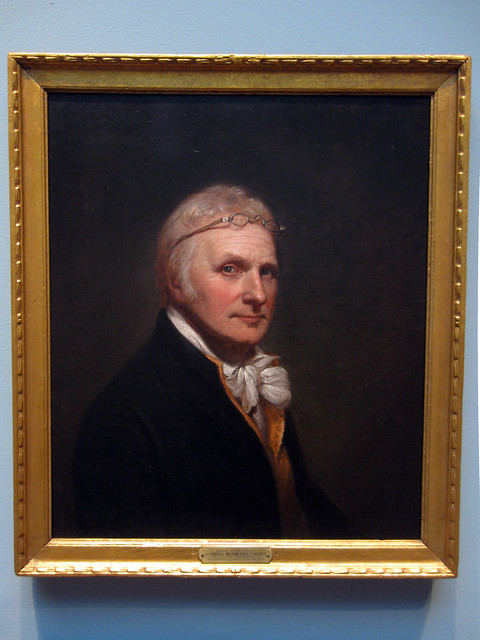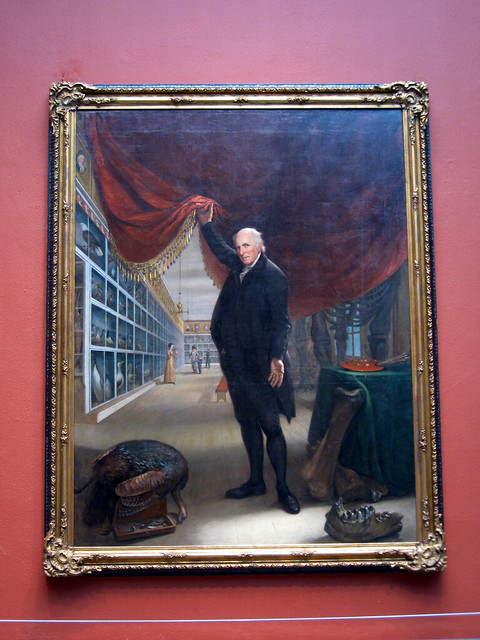
The canny-eyed Peale was a portrait-painter until 1794, when he decided to go into the museum business. After the Revolution, there was a new enthusiasm for education and civic virtue that Peale wanted to reinforce; his museum would "educate and teach virtue to the public by demonstrating the benevolence of the Creator and the order, harmony, and beauty of His creation." As you will see, he accomplished this by packing into this museum every interesting and oddball thing he could get his hands on. He was so dedicated to displaying every facet of the creator's creation that he even wanted to display the embalmed bodies of public figures (posthumously, of course), but had to settle for portraits instead. The popularity of the museum meant it received contributions from all over the world. No description could be better than what you'll read below, but here's a painting of Peale lifting the veil so you can peek into an exhibition:

I happened upon an article about the museum not too long before I went to Philadelphia myself last October. The one thing I would have killed to see was this famous museum, but alas, its contents were sold off about twenty years after Peale's death in 1827. Government support probably would have preserved it, but in spite of his many efforts, he could never the government to agree on that. He had the bad luck to have started his museum when the government was still figuring out what it was and was not allowed to do. Jefferson said he supported the idea of nationalizing the museum, but he didn't think Congress had the power to do so -- or at least, he didn't think they'd think they did. So in the end, Peale's collections went to P. T. Barnum, and most of it was destroyed by fire.
Evidently there's some debate over whether Peale was a forerunner of P. T. Barnum or of the Smithsonian -- whether he was a showman or a man of science. It's silly to suggest he had to be a forerunner of one or the other, and that he couldn't have been a forerunner of both, or neither. Which brings me to this purpose of this post: the list. When the Historian Esq. and I were in Philly, we went (of course) to see Ben Franklin's printing office and bindery.

In demonstrating the presses, they print a lot of random stuff -- sayings and advertisements and articles from early American papers -- and post them on the walls. That is how we spotted this beauty of a list: "Late [that is, recent] Additions to Mr. Peale's Museum." This thing is like a found poem. It is so strange, and wonderful, and revealing as to what eighteenth-century people thought was notable. Was Peale a scientist or a showman? It's impossible to tell. Sometimes the natural world is so weird there's no need to choose.
Unfortunately, the list at the printers was from such an old demonstration that it was no longer for sale, but Historian Esq. pointed out with his customary genius that the library would certainly have this article in a database. And so it did. And so I present to you this final list. Enjoy.
Late ADDITIONS to Mr. PEALE’s MUSEUM.
A fine specimen of Petrified Wood, found in the State of Delaware : Presented by Jonathan B. Smith, Esq.
A pair of Horns of the American Rein-Deer : Presented by Mr. Shingle.
A white Hare, of which species some numbers have appeared in this and the neighbouring northern States within four years past; before that period unknown : Presented by the Hon. Thomas Jefferson.
An Otahitian dress, consisting of a long cloak, and a cap made of feathers, and very elegant; being a present to the president of the United States by some gentlemen of Boston, adventurers in the first voyage made from thence to Nootka Sound and the Otahitian islands; now deposited in the Museum for preservation and safe-keeping for the president.
Chinese ladies shoes, measuring in length 5 4-10 inches : Presented by Mr. Pritchard.
The Nautilus-shell, uncoated and ornamented. A pair of Chinese ladies shoes, made to fit the wife of a native of that country, who supplied the ship (Sampson) with necessaries when at China, and the Podada bird, commonly called the sea-pidgeon : Presented by Mr. Jacob Betteron.
Birds nests, very costly, which, made into a soup, is much esteemed in China, and throughout all the Indies. “When it is reported, that in the Indies people eat birds-nests, there is no man but must wonder at it;--nay, many think they are imposed upon, because it appears to them quite repugnant to nature, or at least very little acceptable to the palate. But they are reckoned good, light, and wholesome food, very proper for sick people. They are so well dressed with other good ingredients, that they prove an excellent dish to those who do not know what it is. As the materials with which they are made come from fish, they are not unsalubrius.”--Postlethwait Dictionary.
A kitten with two heads, in spirits : Presented by Dr. ------------
Two snake-skins, from the island of Trinidad, one measuring in length 7 feet four inches, and the other 13 feet 8 inches : Presented by Mr. Samuel Hazlehurst.
Shells, which are used instead of glass in the windows of the houses of the inhabitants of Malabar : Presented by capt. Howell.
A large flying fish, measuring from the mouth to the extremity of its tail 18 inches : Presented by Mrs. Earl.
A large porcupine fish, measuring 16 ½ inches in length, and two feet three inches circumference, independent of spines : Presented by capt. Howell.
Coisimond, (alive) a very good-humoured, playful animal, from South America : Presented by Mr. Lee.
The ring-tail monkey : Presented by Mr. J. Graham.
A calcarious stone, weighing 21 ½ ounces, taken out of the bladder of a horse : Presented by Mr. Dunkin.
An arrow, which was used against the Americans in the battle of the 4th of November 1791, near the Miami towns : Presented by Dr. Brown
A live rattle-snake : Presented by Dr. Gibbons.
N.B. This is secured in a strong case, with a wired and glass front, and may be viewed in perfect to the spectators, and it is also kept in a room distinct from the museum, so that those who have aversions to such animals need not see it.
That brilliant insect the diamond beatle, from the Brazils, is placed in the museum, with convenient magnifiers for viewing it to advantage.
A large sea-pen : Presented by Mrs. Branton (Willington)
A pair of humming-birds, preserved in a glass case : Presented by Mr. Myers
A pair of ground paroquets, very small and beautiful, from the Streights of Sundy. A Chinese lanthorn. Some incense matches, which are used in the temples in China, and a pair of Turkish knives, in a case, neat and curious : Presented by Mr. Plumstead.
Some improvement in the arrangement of the articles are made. A Gross, for receiving the marine subjects, and a number of rare birds are added.

2 comments:
True story: forehead goggles were a turn of the 19th Century fad thought to give you "foresight" -Philip
Hindsight must've been a bit uncomfortable, then, if not injurious.
Post a Comment